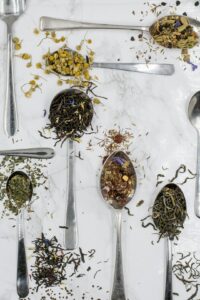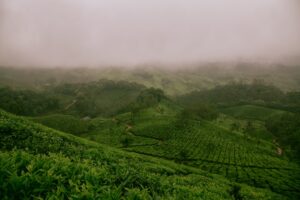Support our educational content for free when you purchase through links on our site. Learn more
Can You Grow and Make Your Own Tea? [2023]
Welcome fellow tea enthusiasts! Are you tired of buying tea from the store and wondering if you can grow and make your own? Well, you've come to the right place! Our team at Growing Teas™ is here to guide you through the wonderful world of growing and making your own tea. Let's dive in and explore the possibilities!
Table of Contents
- Let's Start at the Beginning
- Tea From Leaves
- Tea From Seeds
- Tea From Fruit
- Tea From Flowers
- Tea From Roots
- Frequently Asked Questions
- Quick Tips and Facts
- Useful Links
- Reference Links
Let's Start at the Beginning
Making your own tea can be a rewarding and fulfilling experience. Not only do you have the satisfaction of growing your own plants, but you also get to enjoy the flavors and aromas of teas that are unique to your region and growing conditions.
Whether you have a spacious garden or a small balcony, it's possible to grow tea plants in various environments. The choice of tea plants depends on the climate, soil conditions, and your personal preferences. Some popular tea varieties include Camellia sinensis, Camellia assamica, and Camellia japonica.
Tea From Leaves
The most common way to make tea is by using the leaves of the Camellia sinensis plant. These leaves are rich in polyphenols and other beneficial compounds that contribute to the flavor and health benefits of tea. Here's how you can grow and make your own tea from leaves:
- Choose the Right Tea Plant: Select a tea plant variety that is suitable for your climate and growing conditions. Consider factors like temperature, rainfall, and sunlight when choosing a variety.
- Prepare the Soil: Tea plants prefer well-draining soil that is slightly acidic. Amend the soil with organic matter and ensure good drainage.
- Planting: Dig a hole slightly larger than the root ball of the tea plant. Place the plant in the hole and backfill with soil. Water thoroughly after planting.
- Care and Maintenance: Tea plants require regular watering, especially during the dry season. Prune the plants to maintain their shape and promote healthy growth.
- Harvesting: Depending on the tea variety, leaves can be harvested when they are young and tender. Pluck the leaves and allow them to wither and oxidize before further processing.
- Processing: Once the leaves are harvested, they need to be processed to make tea. This involves withering, rolling, oxidation (for black tea), and drying. Each step contributes to the final flavor and aroma of the tea.
- Enjoy Your Homegrown Tea: After the processing is complete, it's time to brew and savor your homegrown tea. Experiment with different brewing methods and discover your favorite flavors.
Tea From Seeds
If you love experimenting and have the patience to wait for your tea plants to grow from seeds, this method might be for you. Here's how you can grow and make your own tea from seeds:
- Seed Collection: Collect fresh tea seeds from ripe tea plants. If you don't have access to tea plants, consider purchasing seeds from a reputable source.
- Seed Preparation: Soak the seeds in water for 24 hours to enhance germination. Gently rub the seeds to remove the outer seed coat.
- Planting: Fill seedling trays or pots with well-draining potting soil. Plant the tea seeds about half an inch deep and cover them lightly with soil.
- Germination: Place the seedling trays/pots in a warm and humid environment. Tea seeds take about 2-3 weeks to germinate. Mist the soil regularly to keep it moist.
- Transplanting: Once the seedlings have developed a few sets of true leaves, they can be transplanted into larger pots or in the garden. Ensure the proper spacing between the plants.
- Care and Maintenance: Provide adequate water, light, and nutrients to support the growth of tea plants. Protect them from extreme temperatures and pests.
- Harvesting and Processing: Follow the same harvesting and processing steps mentioned in the previous section.
Tea From Fruit
Did you know that some fruits can be used to make delicious tea? If you're feeling adventurous, why not try making tea from fruit? Here are a few fruits that can be infused to create flavorful beverages:
- Lemons: Lemon tea has a refreshing citrus flavor and is rich in vitamin C. Simply squeeze the juice of a lemon into a cup of hot water and add sweetener as desired.
- Berries: Strawberries, raspberries, blueberries, and other berries can be muddled and added to hot water to create fruity teas. Add honey or another sweetener to enhance the taste.
- Apples: Apples can be sliced and brewed with hot water to make a fragrant and comforting tea. Sprinkle some cinnamon for an extra touch of flavor.
- Peaches: Brew peach slices along with hot water to enjoy a fruity and aromatic tea. You can also add some mint leaves for a refreshing twist.
Tea From Flowers
Floral teas are not only beautiful but also enticing to the senses. Here are a few flowers that can be used to make delightful teas:
- Chamomile: Chamomile flowers are known for their calming and soothing properties. Steep dried chamomile flowers in hot water for a relaxing and aromatic tea.
- Lavender: Lavender tea has a delicate floral flavor and is often used for relaxation. Infuse dried lavender flowers in hot water and enjoy the calming effects.
- Rose: Rose petals can be transformed into a fragrant tea that is both visually appealing and delicious. Use fresh or dried rose petals to create your own rose tea.
Tea From Roots
Roots can also be used to make unique and flavorful teas. Here are a couple of roots that you can experiment with:
- Ginger: Ginger root tea has a warming and spicy flavor. Slice a few pieces of fresh ginger root and steep them in hot water for a soothing and invigorating drink.
- Turmeric: Turmeric root tea is known for its anti-inflammatory properties. Grate a small amount of fresh turmeric root and steep it in hot water for a vibrant and healthy tea.
Frequently Asked Questions
Is growing tea difficult?
Growing tea can be a rewarding experience, but it does require some patience and care. Tea plants have specific soil and climate requirements, so it's important to choose the right variety and provide the necessary conditions for their growth. With proper research and maintenance, anyone can successfully grow their own tea plants.
What happens if you plant tea bags?
Planting tea bags in your garden does not result in tea plants. Most tea bags are made from paper or other materials that will break down over time, but they do not contain tea plant seeds or viable growth material. If you want to grow your own tea, it's best to start with tea plant cuttings, seedlings, or seeds.
How do you grow tea for drinking?
To grow tea for drinking, follow the steps mentioned earlier in this article for growing tea from leaves or seeds. Depending on your preferences, choose a tea plant variety, prepare the soil, plant the tea, provide proper care, harvest the leaves, and process them to make tea. With time and practice, you'll be able to create your own customized teas for drinking.
Quick Tips and Facts
- Tea plants prefer acidic soil with a pH range of 6-6.5.
- Camellia sinensis is the most commonly used tea plant for making traditional teas like green, black, and oolong.
- Different tea processing techniques like withering, rolling, oxidation, and drying result in the variety of teas available.
- The quality of tea is influenced by factors like soil conditions, climate, altitude, and harvesting techniques.
- Tea leaves are usually harvested in the morning when the flavors are most concentrated.
Useful Links
- Growing Teas™
- Tea Plants on Amazon
- Tea Collection on Amazon
- Tea Seeds on Amazon
- Tea Infusers on Amazon
- Tea Accessories on Amazon
- Tea Books on Amazon
Reference Links
- https://www.gardeningknowhow.com/edible/herbs/hgen/herbal-tea-plants.htm
- https://aggie-horticulture.tamu.edu/earthkindroses/growing-tips/
- https://www.thespruceeats.com/growing-tea-at-home-766090
- https://www.gardenista.com/posts/field-guide-growing-tea-camellia-sinensis/
- https://www.realsimple.com/food-recipes/recipe-collections-favorites







